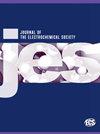用特罗格碱阴离子交换膜缓解锌-碘液流电池中的枝晶生长
IF 3.3
4区 工程技术
Q2 ELECTROCHEMISTRY
引用次数: 0
摘要
通过联苯二胺和二甲氧基甲烷在三氟乙酸存在下缩合聚合,然后用甲基碘进行季铵化,很容易制备出特罗格碱阴离子交换膜(TB-AEM)。用 N-甲基-2-吡咯烷酮(NMP)溶剂浇铸的薄膜具有良好的机械强度,拉伸模量为 1.18 GPa,断裂伸长率为 17%,玻璃化转变温度(Tg)为 248 ℃。在 80 °C 的 1M KOH 溶液中进行阻抗测量时,它的 OH 离子电导率为 108 mS cm-1。该膜对 I2 具有良好的亲和性,从而在膜基质中形成了 I2Br- 离子。在电流密度为 50 mA cm-2 的条件下,经过 300 次充放电循环,电池的库仑效率(CE)达到 95.5%,电压效率(VE)达到 76.4%,能量效率(EE)达到 74.0%,电池容量为 24.8 Ah L-1。在 60 小时的时间跨度内,电池的开路电压(OCV)始终保持在 1.2 V。总之,我们的研究结果表明,阴离子交换膜的电荷和孔隙率调整是设计新一代碘化锌液流电池隔膜的关键因素。用于 ZnI2 氧化还原液流电池的特罗格碱阴离子交换膜的亮点。减少枝晶:通过形成 I2Br- 复合物实现。循环稳定性:在 300 次充放电循环中表现出稳定的性能:95.5%CE)、76.4% 和 74.0% EE,容量为 24.8 Ah L-1。开路电压:在 60 小时内保持恒定在 1.2 V。本文章由计算机程序翻译,如有差异,请以英文原文为准。
Mitigation of Dendrite Growth in Zinc-iodide Flow Battery with Tröger’s Base Anion Exchange Membrane
Tröger’s base anion exchange membrane (TB-AEM) was readily prepared by condensation polymerization of biphenyl diamine and dimethoxymethane in the presence of trifluoroacetic acid followed by quaternization with methyl iodide. The film cast from N-Methyl-2-Pyrrolidone (NMP) solvent displayed good mechanical strength, a tensile modulus of 1.18 GPa with elongation at break of 17%, and a glass transition temperature (Tg) at 248 °C. It exhibited OH− ion conductivity of 108 mS cm−1 by impedance measurement at 80 °C in 1M KOH. The membrane exhibited good affinity toward I2, resulting in the formation of I2Br− ions in the membrane matrix. Over 300 charge/discharge cycles at a 50 mA cm−2 current density, the battery exhibited 95.5% Coulombic efficiency (CE), 76.4% voltage efficiency (VE), and 74.0% energy efficiency (EE) and delivered a capacity of 24.8 Ah L−1. Over a span of 60 h, the open-circuit voltage (OCV) of the cell remained constant at 1.2 V. Collectively, our findings suggest that the anion exchange membrane's charge and porosity tuning are key factors in the design of new generation separators for zinc-iodide flow batteries. Highlights Tröger’s base anion exchange membrane for ZnI2 redox flow battery. Dendrite Mitigation: Achieved through the formation of I2Br− complex. Cycle Stability: Demonstrated stable performance over 300 charge/discharge cycles, with: 95.5% CE), 76.4%, and 74.0% EE, and delivered a capacity of 24.8 Ah L−1. Open-Circuit Voltage: Maintained constant at 1.2 V for 60 h.
求助全文
通过发布文献求助,成功后即可免费获取论文全文。
去求助
来源期刊
CiteScore
7.20
自引率
12.80%
发文量
1369
审稿时长
1.5 months
期刊介绍:
The Journal of The Electrochemical Society (JES) is the leader in the field of solid-state and electrochemical science and technology. This peer-reviewed journal publishes an average of 450 pages of 70 articles each month. Articles are posted online, with a monthly paper edition following electronic publication. The ECS membership benefits package includes access to the electronic edition of this journal.

 求助内容:
求助内容: 应助结果提醒方式:
应助结果提醒方式:


